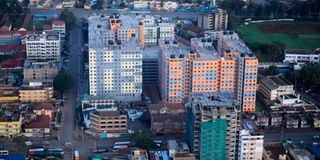Premium
What to expect from the incoming government’s housing docket

An aerial view of affordable housing in Ngara, Nairobi in this photo taken on December 25, 2021.
As the government changes hands, we must all wonder what the new administration means to our individual dreams. For some, the next five years represent academic growth, for others, better health, financial freedom, business growth, and to many, good housing and maybe an enviable real estate investment portfolio.
Whether you are a professional in the property market or an aspiring home owner, you must be eager to see whether the new government will take you a step closer to your dreams. Parties and coalitions tend to make many promises during campaigns, and it is easy to miss the things that really matter. This week, we break down what the Kenya Kwanza brigade promised regarding housing, what was achieved by the incumbent government and the gaps that can be filled.
50 per cent affordable units
The Kenya Kwanza manifesto is a 68-page document - housing is covered on two pages, where the authors outline the government’s plan on making housing affordable and accessible to all. They start by acknowledging the “right to accessible and adequate housing, and to reasonable standards of sanitation” quoting Article 43(b) of the constitution. The Housing Agenda is then divided into three parts: Urban Housing, Rural Housing and Settlement and lastly, Financial Commitment.
The manifesto also acknowledges the glaring deficit of 200,000 units per year, noting that each year, about half a million people migrate to urban centres, translating to ever growing housing demands, yet only two per cent of the houses released into the market cater to low-income earners. Under urban housing, we can expect four things from this administration. First there is a promise to close the housing gap by increasing supply to 250,000 units per year. Out of these new units, there is a promise to increase the percentage of affordable units from 2 percent to 50 per cent, meaning that about 125,000 units will fall under the affordable bracket targeting low-income earners.
And how will this be achieved? “We will achieve this by structuring affordable long-term housing finance schemes, including a National Housing Fund and Cooperative Social Housing Schemes, that will guarantee off take of houses from developers,” reads a quote from the manifesto.
A National Housing Fund is a scheme that allows people to save up for homes, access housing credit at low interests and perhaps repay over a longer period of time compared to what private sector banks demand. Cooperative Social Housing Schemes are likely to cater to a special category of people such as the needy, informal sector workers (who have no payslips) or those with special needs..
Monthly mortgage repayment as low as Sh10,000
The government also aims to increase the number of mortgages from 30,000 to 1 million by reducing the cost of mortgage and making it possible to pay as little as Sh10,000 per month and below in mortgage repayments. This translates to paying the same amount an average Kenyan would pay in rent, or even less. Lastly, the manifesto compares the housing sector to the agriculture industry when it comes to creating quality jobs.
There is a promise to strengthen the Jua Kali industry’s capacity to produce high quality construction products, therefore creating money-making opportunities for those graduating from technical colleges (TVETS). Finally, the government is also open to promoting policies that will incentivise developers and make it easy for them to develop more affordable units.
Settlement Fund for Rural Population
Under rural housing and settlement, the manifesto notes that despite rapid urbanisation, a vast majority of Kenyans still live in their rural homes. These Kenyans, however, grapple with challenges outlined in the manifesto, such as insecure land tenure and the historical squatter problem at the Coast region, for instance. It also notes that rural populations keep growing, putting pressure on available land as manifested by “fragmentation, encroachment of forests and other ecologically sensitive areas and human-wildlife conflict”. Land fragmentation could refer to a scenario where one person owns small pieces of land scattered over a large area or in different locations. Fragmentation makes it difficult to centralise income generating ventures such as farming or large developments.
To solve these challenges, the incoming government promises to establish “a Settlement Fund similar to the one that was used to acquire land from settler farmers after independence”. They also promise to halt land fragmentation and ensure the land purchased by the settlement scheme will be subject to land use planning where beneficiaries will own transferable residential plots. The owners will also have a right to lease non-transferable agricultural land.
The manifesto also mentions policy issues such as taxing of idle land, limits on land subdivision and ceiling on land ownership. These issues are identified as potentially problematic, and though the manifesto does not provide solutions, it recommends friendlier measures to make use of vast, underutilised agricultural land in Kenya.
Finally, on funding, the government commits to finance the housing docket with Sh250 billion for the Financial Year, 2022/23 to Financial Year 2026/27. However, the budget commitment is Sh50 billion, as Sh200 billion is expected to come from pension funds.
Gaps to explore
There is more that the incoming government should consider adding to the list of deliverables. Shelter is a basic need which is constantly evolving. For instance, developers are exploring new materials which cut construction time and cost extensively. Stakeholders around the world are inventing at a very fast rate, but unfortunately, Kenya has only been in the receiving end as it imports most of the new technology. It would be nice to invent within our context, using available resources. But innovation is only possible if manufacturing is made easier.
There is also need for reforms, especially on legal processes that affect the housing sector. Issues such as collapse of buildings and rogue developers getting away with fraud, only to establish other companies and con more people are derailing the property market. Streamlining the agencies that deal with these issues and making it easy for multi-agency collaboration (especially through digitisation of records) would go a long way in cleaning up the market and improving the quality of housing units.
Commercial hubs within devolved units such as the proposed Konza Technopolis will go a long way in creating employment outside the capital city. Rapid migration creates a lot of pressure on large cities, yet there is so much space and flexibility for development in smaller towns. Lastly, as people edge closer to the suburbs and settle in other counties while still working in Nairobi city, there is need for improved transport systems.
Currently, China has the fastest electric train in the world, which travels at a maximum speed of 431km/h. If only we had a train travelling at half that speed, it would take just a few minutes to move through counties. Such innovations should inspire us to improve our transport systems.




